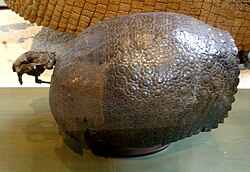Propalaehoplophorus
|
Propalaehoplophorus Temporal range: Early Miocene (Santacrucian-Friasian) ~17.5–15.5 Ma |
|
|---|---|
 |
|
| Propalaeohoplophorus minor | |
| Scientific classification | |
| Kingdom: | Animalia |
| Phylum: | Chordata |
| Class: | Mammalia |
| Superorder: | Xenarthra |
| Order: | Cingulata |
| Family: | Chlamyphoridae |
| Subfamily: | †Glyptodontinae |
| Genus: |
†Propalaehoplophorus Ameghino 1887 |
| Species | |
|
|
| Synonyms | |
|
|
Propalaehoplophorus, also written as Propalaeohoplophorus, is an extinct genus of glyptodont, which lived in South America during the Early Miocene epoch.
Fossils of Propalaehoplophorus have been found in the Santa Cruz Formation of Argentina, the Honda Group and Nazareno Formation of Bolivia and the Río Frías Formation of Chile.
Restorations of Hapalops longiceps and Propalaeohoplophorus australis
Detail of a P. australis scute, early Miocene, in the permanent collection of The Children’s Museum of Indianapolis
...
Wikipedia
